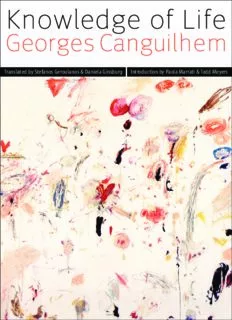
Knowledge of life PDF
Preview Knowledge of life
K n o w ledge of Li f e George s Canguilh e m Translated by Stefanos Geroulanos & Daniela Ginsburg Introduction by Paola Marrati & Todd Meyers Knowledge ofLife .................17186$ $$FM 11-13-0815:04:25 PS PAGEi PhotographofGeorgesCanguilhem,1993,courtesyofFranc¸oisDelaporte. .................17186$ $$FM 11-13-0815:04:31 PS PAGEii Knowledge of Life Georges Canguilhem Edited by Paola Marrati and Todd Meyers Translated by Stefanos Geroulanos and Daniela Ginsburg fordham university press new york 2008 .................17186$ $$FM 11-13-0815:04:31 PS PAGEiii Copyright(cid:2)2008FordhamUniversityPress Allrightsreserved.Nopartofthispublicationmaybereproduced, storedinaretrievalsystem,ortransmittedinanyformorbyany means—electronic,mechanical,photocopy,recording,orany other—exceptforbriefquotationsinprintedreviews,withoutthe priorpermissionofthepublisher. FordhamUniversityPresshasnoresponsibilityforthepersistence oraccuracyofURLsforexternalorthird-partyInternetwebsites referredtointhispublicationanddoesnotguaranteethatany contentonsuchwebsitesis,orwillremain,accurateorappropriate. KnowledgeofLifewasfirstpublishedinFrenchasLaconnaissancede lavie(cid:2)LibrairiePhilosophiqueJ.Vrin1965;(cid:2)1992,2003forthe paperbackedition. Cetouvrage,publie´ danslecadred’unprogrammed’aidea` la publication,be´ne´ficiedusoutienduMiniste`redesAffaires e´trange`resetduServiceCultureldel’AmbassadedeFranceaux Etats-Unis. Thiswork,publishedaspartofaprogramofaidforpublication, receivedsupportfromtheFrenchMinistryofForeignAffairsand theCulturalServicesoftheFrenchEmbassyintheUnitedStates. LibraryofCongressCataloging-in-PublicationDataisavailable fromthepublisher. PrintedintheUnitedStatesofAmerica 10 09 08 5 4 3 2 1 Firstedition .................17186$ $$FM 11-13-0815:04:32 PS PAGEiv contents Foreword:Life,asSuch vii byPaolaMarratiandToddMeyers Translators’Note byStefanosGeroulanosandDanielaGinsburg xiii Introduction:ThoughtandtheLiving xvii PartOne Method 1. ExperimentationinAnimalBiology 3 PartTwo History 2. CellTheory 25 PartThree Philosophy 3. Aspectsof Vitalism 59 4. MachineandOrganism 75 5. TheLiving andItsMilieu 98 6. TheNormalandthePathological 121 7. MonstrosityandtheMonstrous 134 v .................17186$ CNTS 11-13-0815:04:29 PS PAGEv vi Contents Appendixes 1. NoteontheTransition fromFibrillarTheorytoCell Theory 149 2. NoteontheRelationship BetweenCellTheoryand Leibniz’sPhilosophy 151 3. Extractsfromthe‘‘Discourssur l’anatomieducerveau’’ (‘‘DiscourseontheAnatomyoftheBrain’’),deliveredby NicolasStenoinParisin1665tothe‘‘Messieursde l’Assemble´edechezMonsieur The´venot’’ inParis 152 Notes 155 Bibliography 183 .................17186$ CNTS 11-13-0815:04:29 PS PAGEvi foreword Life,asSuch PaolaMarratiandToddMeyers Trainedinphilosophyandmedicine,GeorgesCanguilhem(1904–95)con- tinues to exert tremendous influence on the history and philosophy of sci- ence—aninfluencethatcanhardlybeoverstated.Canguilhem wasamajor point of contact between philosophersin France throughout the twentieth century, including figures such as Michel Foucault, Louis Althusser, Fran- c¸ois Jacob, Jacques Lacan, Pierre Bourdieu, and Jacques Derrida, to name onlyafew.Overhislongcareer,CanguilhemwasaprofessorinStrasbourg andattheSorbonne,wherehetookoverfromGastonBachelardasdirector of the Institut d’Histoire des Sciences et Techniques of the University of Paris.Healsoservedasinspectorgeneralofphilosophyandlaterasamem- beroftheFrenchagre´gationcommittee,apositionthatgavehimconsider- ablepoweroverexaminationsandtraininginphilosophy.Inhismostwidely knownwork,Essaisurquelquesproble`mesconcernantlenormaletlepathologique (1943), later republished under the title Le normal et le pathologique (1966; in English as The Normal and the Pathological), Canguilhem addressed how theconceptsofthe‘‘normal’’andthe‘‘pathological’’ariseandtakeholdin medicine.InLaformationduconceptdere´flexeauxXVIIetXVIIIsie`cles(1955), heturnedhisattentiontotheformationoftheconceptof‘‘reflex’’andhow it shaped ideas in the history of biology and physiology. Other works by CanguilhemthathavebeentranslatedintoEnglishincludeIdeologyandRa- tionalityintheHistoryoftheLifeSciences(1988)andAVitalRationalist:Selected WritingsofGeorgesCanguilhem(1994). vii .................17186$ FRWD 11-13-0815:04:32 PS PAGEvii viii Foreword In the opening statements of his introduction to Knowledge of Life, Georges Canguilhem strongly affirms what can be considered the guiding threadnot onlyof theeight essayscollected inthe volumebut ofall of his philosophical,historical,andepistemologicalworks.1AccordingtoCanguil- hem, contrary to what a long and influential tradition holds, there is no conflict between knowledge and life, no fundamental divide between the supposedly pure and disinterested procedure of reason and science, on the one hand, and the supposedly obscure and irrational power of life, on the other. Canguilhem considers these two complementary assumptions to be deeply misleading: they are prejudicial both to the task of the historian of scienceandtothearguablyevenmoreimportanttaskofunderstandingthe specificityofthehumanformoflife. Knowledge, like any otherhuman activity, cannotavoid thequestion of itsmeaning;thosewhobelievethatknowledgeexistsforitsownsake,asan autonomousquestthatwouldsetapartthosewhopursueitfrom‘‘life’’and its needs, in Canguilhem’s view, simultaneously admit the necessity of a meaningofknowledgeandfailtoassignone.Theyfailtoseethatthinking and knowing do not separate humans from life. Rather, they separate hu- mansfromtheworldandtheirmilieu;theycreatethedistancenecessaryto doubtandevaluate,tolookforwaystoovercomeobstacles,reduceinsecuri- ties. Knowledge, for Canguilhem, is a ‘‘general method’’ for solving, di- rectlyorindirectly,thetensionsthatarisebetweenhumansandthemilieu. The conflict is not between knowledge and life but between humans and the milieu: knowledge, as a human practice, is a way of transforming the world, of finding a new balance with the milieu, of creating a new form of life.In this sense,knowledgeis aformoflife, belongstolife, butthenlife, human and nonhuman, cannot be considered a ‘‘blind and stupid’’ force.2 Torecognizethatknowledgeisneverforitsownsakebutbelongstoaform of life that it constantly helps to renegotiate and modify calls not only for a different conception of knowledge but also for an altogether different understandingoflife. Groundingknowledgeinlifedoesnot,forCanguilhem,amounttoques- tioning the ambitions of reason and rationality, to underplaying science as autilitariandeviceamongothers:heaims,onthecontrary,tohighlightthe fact that life as such produces knowledge, that there is nothing essentially irrationalaboutitspower,asisassumedbythosewhoopposelifetothought. Humans do not need to separate themselves out from the realm of living .................17186$ FRWD 11-13-0815:04:32 PS PAGEviii Foreword ix beings in order to think, to forget that they are animals; certainly, humans exercise thought to a higher degree, and animals cannot solve most of the problems that we set up for them. But this is because, Canguilhem notes, theseareourproblems,nottheirs.Knowledge,asthecapacitytosolveprob- lems, may and indeed does vary in different animals, but it is produced by life.Hencethedoublemeaningofthetitle:‘‘knowledgeoflife’’issimulta- neously and inseparably the knowledge we have of life when we take it as onobject,andtheknowledgethatlifeitselfproduces. The awareness of the reciprocal belonging of life and knowledge not only undoes the deeply rooted divide between an abstract conception of knowledge and a murky perception of life: it also demands respect for the specificityof thelivingas anobjectof science. InCreative Evolution,Henri Bergson insists on the intimate interplay between life and knowledge: emerging from life as one of its products, knowledge in turn modifies life. Human cognitive practices emerge as a particularly powerful instance of a tendency that is expressed by all living beings: the capacity to solve prob- lems in new and creative ways. The difference that constitutes living does notconsistinaninexplicableforcethatwillforevereludesciencebutinthis internal and active relation to knowledge.3 Canguilhem’s preoccupations are certainly different from those of Bergson, but on this critical point he acceptsthelegacyofCreativeEvolutionand,moregenerally,ofvitalism. Canguilhem’s continually reaffirmed interest in the different traditions of vitalism is not a purely historical one but, rather, methodological and philosophical.Vitalism,asheunderstandsit,isfirstandforemostademand: it cannot be identified with any specific medical or biological doctrine; it does not consist in the affirmation of any particular set of properties that woulddefine‘‘life.’’Whatvitalismaffirmsistheneedtokeepthequestion of the sense of the relation between life and science open: such a question in its general form is important from a philosophical or epistemological perspective,butitbecomesparticularlypressingforthelifesciences,which cannotignoreitwithoutcompromisingtheirowninquiries.Thespecificity ofbiologyormedicine,forCanguilhem,isnotduetoastateofknowledge thatisinsufficentlyadvanced(agapthatrecentdiscoveries,somemayargue, wouldhavefilled)butisirreducible.Thespecificityofbiologyandmedicine depends on the fact that living beings have a normative relation to life. By ‘‘normative,’’Canguilhemmeansthatlivingbeingsarenot,andcannot,be indifferenttotheconditionsoftheirlife,bothtotheinternalconditionsof .................17186$ FRWD 11-13-0815:04:33 PS PAGEix
Description: